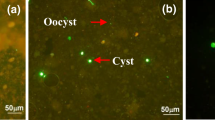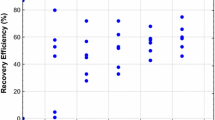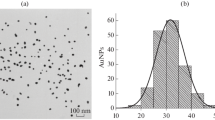Abstract
This study evaluated the technology of detection of Giardia spp. cysts and Cryptosporidium spp. oocysts in environmental matrices obtained after water treatment on a bench scale. Calcium carbonate flocculation with immunomagnetic separation was the selected method to quantify the protozoa, and the importance of the number of acid dissociations in the immunomagnetic separation was assessed. When adding the third acid dissociation, an increase of 71% ± 6 in floated residue and 31.9% ± 28.7 in filter backwash water in cyst recovery was observed, while in oocyst recovery, a non-significant increase was detected. In the filtered water, this increased dissociation was important in the protozoa recovery with increases greater than 33%. The results showed that there is a strong interaction of these target organisms with the magnetic microspheres, since protozoa were still recovered in the third acid dissociation and some of them were still adhered to the magnetic microspheres.


Similar content being viewed by others
References
Andreoli FC, Sabogal-Paz LP (2019) Coagulation, flocculation, dissolved air flotation and filtration in the removal of Giardia spp. and Cryptosporidium spp. from water supply. Environ Technol 40(5):654–663
APHA - American Public Health Association/American Water Works Association/Water Environment Federation. Standard methods for the examination of water and wastewater; Washington DC, USA, 2012
Baldursson S, Karanis P (2011) Waterborne transmission of protozoan parasites: review of worldwide outbreaks – an update 2004–2010. Water Res 45:6603–6614
Chang CY, Huang C, Pan JR, Wu BJ (2007) Modification of immunomagnetic separation procedures for analysis of Cryptosporidium at spiked oocysts and turbid sample conditions. J Environ Eng Manag 17:333
Cho EJ, Yang JY, Lee ES, Kim SC, Cha SY, Kim ST, Park YS (2013) A waterborne outbreak and detection of Cryptosporidium oocysts in drinking water of an older high-rise apartment complex in Seoul. Korean J Parasitol 51:461–466
Daly ER, Roy SJ, Blaney DD, Manning JS, Hill VR, Xiao L, Stull JW (2010) Outbreak of giardiasis associated with a community drinking-water source. Epidemiol Infect 138:491–500
Efstratiou A, Ongerth JE, Karanis P (2017a) Waterborne transmission of protozoan parasites: review of worldwide outbreaks - an update 2011–2016. Water Res 114:14–22
Efstratiou A, Ongerth J, Karanis P (2017b) Evolution of monitoring for Giardia and Cryptosporidium in water. Water Res 123:96–112
Feng Y, Zhao X, Chen J, Jin W, Zhou X, Li N, Xiao L (2011) Occurrence, source, and human infection potential of Cryptosporidium and Giardia spp. in source and tap water in Shanghai, China. Appl Environ Microbiol 77:3609–3616
Giglio GL, Sabogal-Paz LP (2018) Performance comparison of three methods for detection of Giardia spp. cysts and Cryptosporidium spp. oocysts in drinking-water treatment sludge. Environ Monit Assess 190:686
Karanis P, Kourenti C, Smith H (2007) Waterborne transmission of protozoan parasites: a worldwide review of outbreaks and lessons learnt. J Water Health 5:1–38
Keegan A, Daminato D, Saint CP, Monis PT (2008) Effect of water treatment processes on Cryptosporidium infectivity. Water Res:42, 1805–1811
Koh W, Clode PL, Monis P, Thompson RA (2013) Multiplication of the waterborne pathogen Cryptosporidium parvum in an aquatic biofilm system. Parasit Vectors 6:270
Kooy M, Walter CT (2019) Towards a situated urban political ecology analysis of packaged drinking water supply. Water 11:225
Korich DG, Mead JR, Madore MS, Sinclair NA, Sterling CR (1990) Effects of ozone, chlorine dioxide, chlorine, and monochloramine on Cryptosporidium parvum oocyst viability. Appl Environ Microbiol 56:1423–1428
Maciel PMF, Sabogal-Paz LP (2016) Removal of Giardia spp. and Cryptosporidium spp. from water supply with high turbidity: analytical challenges and perspectives. J Water Health 14:369–378
Olson ME, Goh J, Phillips M, Guselle N, McAllister TA (1999) Giardia cyst and Cryptosporidium oocyst survival in water, soil, and cattle feces. J Environ Quality 28:1991–1996
Rochelle PA, De Leon R, Johnson A, Stewart MH, Wolfe RL (1999) Evaluation of immunomagnetic separation for recovery of infectious Cryptosporidium parvum oocysts from environmental samples. Appl Environ Microbiol 65:841–845
Rosado-García FM, Guerrero-Flórez M, Karanis G, Hinojosa MDC, Karanis P (2017) Water-borne protozoa parasites: the Latin American perspective. Int J Hyg Environ Health 220:783–798
Schofield T (2001) Dissolved air flotation in drinking water production. Water Sci Technol 43:9–18
USEPA – United Stated Environmental Protection Agency. Method 1623.1: Cryptosporidium and Giardia in water by filtration/IMS/FA; Office of Water, EPA 816-R-12-001, 2012
Vesey G, Slade JS, Byrne M, Shepherd K, Fricker CR (1993) A new method for the concentration of Cryptosporidium oocysts from water. J Appl Bacteriol 75:82–86
Walker MJ, Montemagno CD, Jenkins MB (1998) Source water assessment and nonpoint sources of acutely toxic contaminants: a review of research related to survival and transport of Cryptosporidium parvum. Water Resour Res 34:3383–3392
Funding
The authors are grateful to the São Paulo Research Foundation (FAPESP) (Process 12/50522-0), the Global Challenges Research Fund (GCRF) UK Research and Innovation (SAFEWATER; EPSRC Grant Reference EP/P032427/1) for the research support and the National Council for Scientific and Technological Development (CNPq-Brazil) for the Master’s scholarship awarded to Fernando César Andreoli.
Author information
Authors and Affiliations
Corresponding author
Ethics declarations
Conflict of interest
The authors declare that they have no conflict of interest.
Additional information
Handling Editor: Julia Walochnik
Publisher’s note
Springer Nature remains neutral with regard to jurisdictional claims in published maps and institutional affiliations.
Rights and permissions
About this article
Cite this article
Andreoli, F.C., Sabogal-Paz, L.P. Detection of Giardia and Cryptosporidium in environmental matrices with immunomagnetic separation: two or three acid dissociations. Parasitol Res 120, 629–635 (2021). https://doi.org/10.1007/s00436-020-06999-4
Received:
Accepted:
Published:
Issue Date:
DOI: https://doi.org/10.1007/s00436-020-06999-4




